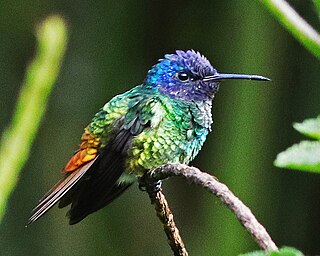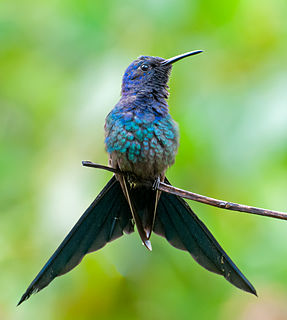
Erythrina is a genus of flowering plants in the pea family, Fabaceae. It contains about 130 species, which are distributed in tropical and subtropical regions worldwide. They are trees, with the larger species growing up to 30 m (98 ft) in height. The generic name is derived from the Greek word ερυθρóς (erythros), meaning "red", referring to the flower color of certain species.

Erythrina herbacea, commonly known as the coral bean, Cherokee bean, Mamou plant in South Louisiana, red cardinal or cardinal spear, is a flowering shrub or small tree found throughout the southeastern United States and northeastern Mexico; it has also been reported from parts of Central America and, as an introduced species, from Pakistan. Various other systematic names have been used for this plant in the past, including Erythrina arborea, Erythrina hederifolia, Erythrina humilis, Erythrina rubicunda, Corallodendron herbaceum and Xyphanthus hederifolius.

Wiliwili, is a species of flowering tree in the pea family, Fabaceae, that is endemic to the Hawaiian Islands. It is the only species of Erythrina that naturally occurs there. It is typically found in Hawaiian tropical dry forests on leeward island slopes up to an elevation of 600 m (2,000 ft).

The black-throated mango is a hummingbird species native to South America and Trinidad and Tobago.

Erythrina crista-galli, often known as the cockspur coral tree, is a flowering tree in the family Fabaceae, native to Argentina, Uruguay, southern Brazil and Paraguay. It is widely planted as a street or garden tree in other countries, notably in California. It is known by several common names within South America: ceibo, seíbo (Spanish), corticeira (Portuguese) and the more ambiguous bucaré, to name a few. Its specific epithet crista-galli means "cock's comb" in Latin.

Ceiba speciosa, the floss silk tree, is a species of deciduous tree native to the tropical and subtropical forests of South America. It has several local common names, such as palo borracho or árbol del puente, samu'ũ or paineira. In Bolivia, it is called toborochi, meaning "tree of refuge" or "sheltering tree". It belongs to the same family as the baobab and the kapok. Another tree of the same genus, Ceiba chodatii, is often referred to by the same common names.

Erythrina variegata, commonly known as tiger's claw or Indian coral tree, is a species of Erythrina native to the tropical and subtropical regions of eastern Africa, the Indian subcontinent, northern Australia, and the islands of the Indian Ocean and the western Pacific Ocean east to Fiji.

Erythrina fusca is a species of flowering tree in the legume family, Fabaceae. It is known by many common names, including purple coraltree, gallito, bois immortelle, bucayo, and the more ambiguous "bucare" and "coral bean". E. fusca has the widest distribution of any Erythrina species; it is the only one found in both the New and Old World. It grows on coasts and along rivers in tropical Asia, Oceania, the Mascarene Islands, Madagascar, Africa, and the Neotropics.

The green-bellied hummingbird is a species of hummingbird in the "emeralds", tribe Trochilini of subfamily Trochilinae. It is found in Brazil, Colombia, Guyana, Suriname, Venezuela, and as a vagrant in French Guiana.

The Veraguan mango is a species of hummingbird in the family Trochilidae. It is found in Panama and recently in Costa Rica. It was considered conspecific with the Green-breasted Mango but was separated due to morphological and geographical differences in 1995.

The golden-tailed sapphire is a species of hummingbird in the family Trochilidae. It is found in Bolivia, Brazil, Colombia, Ecuador, Peru, and Venezuela.

The swallow-tailed hummingbird is a species in the hummingbird family (Trochilidae), found mainly in east-central South America. Most authorities place it in the genus Eupetomena, although some place it in Campylopterus based on song and the thick shafts of the males' first primaries. Its common name and specific epithet both refer to the long, deeply forked, somewhat swallow-like tail.

The garnet-throated hummingbird is a species of hummingbird in tribe Lampornithini of subfamily Trochilinae. It is found in El Salvador, Guatemala, Honduras, and Mexico.

The sapphire-bellied hummingbird is an Endangered species of hummingbird in the "emeralds", tribe Trochilini of subfamily Trochilinae. It is endemic to Colombia.

The black-backed thornbill is an Endangered species of hummingbird in the "coquettes", tribe Lesbiini of subfamily Lesbiinae. It is endemic to the Sierra Nevada de Santa Marta of northern Colombia.

Erythrina velutina is a species of leguminous tree. It is indigenous to Brazil, Peru, Ecuador, Colombia, Venezuela, and Hispaniola and has been introduced to much of the Caribbean, Uganda, and Sri Lanka. It also occurs on the Galápagos Islands, but whether it is indigenous or introduced there is unclear. In Brazil, it occurs on plains and near rivers in the arid parts of the northeast of the country and is commonly known as "mulungu". Erythrina velutina grows as a large tree to around 10 m (30 ft) high and has short spines on the stem. It is perennial.

Erythrina America, is a flowering plant of the genus Erythrina which is native to Mexico. Colorín is the name of a type of tree, Erythrina americana also called Tzompāmitl. The word colorín means color chillón—a “gaudy” or “loud” color.

Ferdinandusa is a genus of flowering plants in the family Rubiaceae, native to the American tropics.

Erythrina berteroana is a species of small deciduous tree in the family Fabaceae. It is found in Mexico, Central America and the northern part of South America. Common names include elequeme, gallito, machete, pernila de casa, pito and poró de cerca. It is a common tree in the drier parts of its range and has many traditional uses.

Erythrina senegalensis, the Senegal coraltree, is a plant in the pea family Fabaceae, native to West Africa.






















